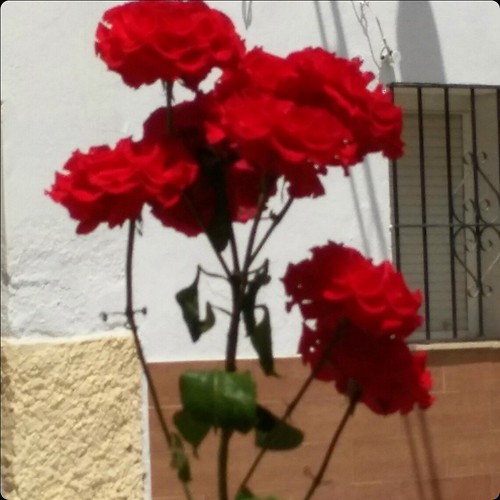Derived from Nox2 knockout mice (Nox2KO) under basal growing conditions. We observed no difference in the global actin architecture between WT and Nox2KO BMMs but did find that Nox2KO BMM had a larger spread area and were reproducibly more elongated compared to WT BMM (Figure 1a and b). CSF-1 is well known to stimulate cell morphology changes in BMMS [17], where deprivation of CSF1 induces cell elongation and re-stimulation leads to centrifugal spreading [17]. Therefore we next tested whether Nox2 expression was required for a morphological response to CSFTime-lapse Microscopy and Migration AnalysisTo study random cell motion, cells were seeded onto 6 well plastic petri dishes at a density of 26104 cells/ml in macrophage growth medium and incubated overnight. Epigenetics following incubation, cells were starved of CSF-1 in macrophage starve medium for 8 hours. The cells were then stimulated with CSF-1 by the reintroduction of CSF-1 (30 ng/ml) containing growth media. Cell images were collected using a Pulnix CCCD camera, taking aNox2 and Chemotaxis1. Interestingly, following CSF-1 deprivation, WT and Nox2KO macrophages Epigenetic Reader Domain reduced their area to a similar size (Figure 2). Moreover, CSF-1 stimulation induced cell spreading in both WT and Nox2KO BMMs (Figure 2). However whilst, WT macrophages exhibited an increase of 79 in  spread area compared to their spread area under starved conditions Nox2KO macrophages only exhibited a 55 increase after 5 minutes of CSF-1 stimulation. Although not statistically significant, taken together with the reduced cell area for growing cells, these data do suggest that Nox2 expression is in part required for normal BMM behaviour. Interestingly, both populations were able to centrifugally spread in response to CSF-1 (Figure 2), suggesting that CSF-1 responses are not completely dependent on Nox2 in BMMs.Nox22/2 BMM Showed Reduced Random Motion Following CSF-1 StimulationGiven that we had observed a change in growing cell spread area and a reduction in the spread area in response to CSF-1,we speculated that Nox2KO BMMs might have defects in CSF1 simulated migration. Initially we tested random migration and found that there was a small but reproducible reduction in cell migration speed observed in the Nox2KO population. In the presence of CSF-1 WT cells exhibited a mean migration speed of 0.71 mm/min whilst Nox2KO BMMs exhibited a mean migration speed of 0.67 mm/min (Figure 3E). Moreover we found a significant reduction (p = 0.02), in cell displacement (Figure 3C and D). Where a reduced number of the Nox2KO BMMs population were able to reach the set horizon compared to WT BMMs. We speculate that this may be due in part to the slightly reduced cell speed but could also be attributed to the observation that Nox2KO BMMs tended to oscillate in movement more than WT BMMs and therefore not achieve overall displacement, this is partly reflected in the increased persistence of migration (Figure 3F) we recorded for the Nox2KO BMMs. These results suggest that Nox2 does play a role in the migration of BMMs following CSF-1 stimulation.Figure 1. Nox2KO BMMs have increased cell area. a) WT and Nox2KO BMMs were fixed and stained for F-actin. b) Cell area and cell elongation analysis was conducted using ImageJ software. Representative of three independent experiments with .30 cells measured for each experiment.* = p,0.05. doi:10.1371/journal.pone.0054869.gNox2 and ChemotaxisFigure 2. BMMs respond to CSF-1 stimulation. Cells were seeded on co.Derived from Nox2 knockout mice (Nox2KO) under basal growing conditions. We observed no difference in the global actin architecture between WT and Nox2KO BMMs but did find that Nox2KO BMM had a larger spread area and were reproducibly more elongated compared to WT BMM (Figure 1a and b). CSF-1 is well known to stimulate cell morphology changes in BMMS [17], where deprivation of CSF1 induces cell elongation and re-stimulation leads to centrifugal spreading [17]. Therefore we next tested whether Nox2 expression was required for a morphological response to CSFTime-lapse Microscopy and Migration AnalysisTo study random cell motion, cells were seeded onto 6 well plastic petri dishes at a density of 26104 cells/ml in macrophage growth medium and incubated overnight. Following incubation, cells were starved of CSF-1 in macrophage starve medium for 8 hours. The cells were then stimulated with CSF-1 by the reintroduction of CSF-1 (30 ng/ml) containing growth media. Cell images were collected using a Pulnix CCCD camera, taking aNox2 and Chemotaxis1. Interestingly, following CSF-1 deprivation, WT and Nox2KO macrophages reduced their area to a similar size (Figure 2). Moreover, CSF-1 stimulation induced cell spreading in both WT and Nox2KO BMMs (Figure 2). However whilst, WT macrophages exhibited an increase of 79 in spread area compared to their spread area under starved conditions Nox2KO macrophages only exhibited a 55 increase after 5 minutes of CSF-1 stimulation. Although not statistically significant, taken together with the reduced cell area for growing cells, these data do suggest that Nox2 expression is in part required for normal BMM behaviour. Interestingly, both populations were able to centrifugally spread in response to CSF-1 (Figure 2), suggesting that CSF-1 responses are not completely dependent on Nox2 in BMMs.Nox22/2 BMM Showed Reduced Random Motion Following CSF-1 StimulationGiven that we had observed a change in growing cell spread area and a reduction in the spread area in response to CSF-1,we speculated that Nox2KO BMMs might have defects in CSF1 simulated migration. Initially we tested random migration and found that there was a small but reproducible reduction in cell migration speed observed in the Nox2KO population. In the presence of CSF-1 WT cells exhibited a mean migration speed of 0.71 mm/min whilst Nox2KO BMMs exhibited a mean migration speed of 0.67 mm/min (Figure 3E). Moreover we found a significant reduction (p = 0.02), in
spread area compared to their spread area under starved conditions Nox2KO macrophages only exhibited a 55 increase after 5 minutes of CSF-1 stimulation. Although not statistically significant, taken together with the reduced cell area for growing cells, these data do suggest that Nox2 expression is in part required for normal BMM behaviour. Interestingly, both populations were able to centrifugally spread in response to CSF-1 (Figure 2), suggesting that CSF-1 responses are not completely dependent on Nox2 in BMMs.Nox22/2 BMM Showed Reduced Random Motion Following CSF-1 StimulationGiven that we had observed a change in growing cell spread area and a reduction in the spread area in response to CSF-1,we speculated that Nox2KO BMMs might have defects in CSF1 simulated migration. Initially we tested random migration and found that there was a small but reproducible reduction in cell migration speed observed in the Nox2KO population. In the presence of CSF-1 WT cells exhibited a mean migration speed of 0.71 mm/min whilst Nox2KO BMMs exhibited a mean migration speed of 0.67 mm/min (Figure 3E). Moreover we found a significant reduction (p = 0.02), in cell displacement (Figure 3C and D). Where a reduced number of the Nox2KO BMMs population were able to reach the set horizon compared to WT BMMs. We speculate that this may be due in part to the slightly reduced cell speed but could also be attributed to the observation that Nox2KO BMMs tended to oscillate in movement more than WT BMMs and therefore not achieve overall displacement, this is partly reflected in the increased persistence of migration (Figure 3F) we recorded for the Nox2KO BMMs. These results suggest that Nox2 does play a role in the migration of BMMs following CSF-1 stimulation.Figure 1. Nox2KO BMMs have increased cell area. a) WT and Nox2KO BMMs were fixed and stained for F-actin. b) Cell area and cell elongation analysis was conducted using ImageJ software. Representative of three independent experiments with .30 cells measured for each experiment.* = p,0.05. doi:10.1371/journal.pone.0054869.gNox2 and ChemotaxisFigure 2. BMMs respond to CSF-1 stimulation. Cells were seeded on co.Derived from Nox2 knockout mice (Nox2KO) under basal growing conditions. We observed no difference in the global actin architecture between WT and Nox2KO BMMs but did find that Nox2KO BMM had a larger spread area and were reproducibly more elongated compared to WT BMM (Figure 1a and b). CSF-1 is well known to stimulate cell morphology changes in BMMS [17], where deprivation of CSF1 induces cell elongation and re-stimulation leads to centrifugal spreading [17]. Therefore we next tested whether Nox2 expression was required for a morphological response to CSFTime-lapse Microscopy and Migration AnalysisTo study random cell motion, cells were seeded onto 6 well plastic petri dishes at a density of 26104 cells/ml in macrophage growth medium and incubated overnight. Following incubation, cells were starved of CSF-1 in macrophage starve medium for 8 hours. The cells were then stimulated with CSF-1 by the reintroduction of CSF-1 (30 ng/ml) containing growth media. Cell images were collected using a Pulnix CCCD camera, taking aNox2 and Chemotaxis1. Interestingly, following CSF-1 deprivation, WT and Nox2KO macrophages reduced their area to a similar size (Figure 2). Moreover, CSF-1 stimulation induced cell spreading in both WT and Nox2KO BMMs (Figure 2). However whilst, WT macrophages exhibited an increase of 79 in spread area compared to their spread area under starved conditions Nox2KO macrophages only exhibited a 55 increase after 5 minutes of CSF-1 stimulation. Although not statistically significant, taken together with the reduced cell area for growing cells, these data do suggest that Nox2 expression is in part required for normal BMM behaviour. Interestingly, both populations were able to centrifugally spread in response to CSF-1 (Figure 2), suggesting that CSF-1 responses are not completely dependent on Nox2 in BMMs.Nox22/2 BMM Showed Reduced Random Motion Following CSF-1 StimulationGiven that we had observed a change in growing cell spread area and a reduction in the spread area in response to CSF-1,we speculated that Nox2KO BMMs might have defects in CSF1 simulated migration. Initially we tested random migration and found that there was a small but reproducible reduction in cell migration speed observed in the Nox2KO population. In the presence of CSF-1 WT cells exhibited a mean migration speed of 0.71 mm/min whilst Nox2KO BMMs exhibited a mean migration speed of 0.67 mm/min (Figure 3E). Moreover we found a significant reduction (p = 0.02), in  cell displacement (Figure 3C and D). Where a reduced number of the Nox2KO BMMs population were able to reach the set horizon compared to WT BMMs. We speculate that this may be due in part to the slightly reduced cell speed but could also be attributed to the observation that Nox2KO BMMs tended to oscillate in movement more than WT BMMs and therefore not achieve overall displacement, this is partly reflected in the increased persistence of migration (Figure 3F) we recorded for the Nox2KO BMMs. These results suggest that Nox2 does play a role in the migration of BMMs following CSF-1 stimulation.Figure 1. Nox2KO BMMs have increased cell area. a) WT and Nox2KO BMMs were fixed and stained for F-actin. b) Cell area and cell elongation analysis was conducted using ImageJ software. Representative of three independent experiments with .30 cells measured for each experiment.* = p,0.05. doi:10.1371/journal.pone.0054869.gNox2 and ChemotaxisFigure 2. BMMs respond to CSF-1 stimulation. Cells were seeded on co.
cell displacement (Figure 3C and D). Where a reduced number of the Nox2KO BMMs population were able to reach the set horizon compared to WT BMMs. We speculate that this may be due in part to the slightly reduced cell speed but could also be attributed to the observation that Nox2KO BMMs tended to oscillate in movement more than WT BMMs and therefore not achieve overall displacement, this is partly reflected in the increased persistence of migration (Figure 3F) we recorded for the Nox2KO BMMs. These results suggest that Nox2 does play a role in the migration of BMMs following CSF-1 stimulation.Figure 1. Nox2KO BMMs have increased cell area. a) WT and Nox2KO BMMs were fixed and stained for F-actin. b) Cell area and cell elongation analysis was conducted using ImageJ software. Representative of three independent experiments with .30 cells measured for each experiment.* = p,0.05. doi:10.1371/journal.pone.0054869.gNox2 and ChemotaxisFigure 2. BMMs respond to CSF-1 stimulation. Cells were seeded on co.